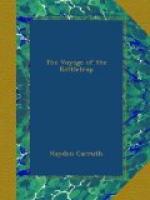The next day we decided to visit Lead City (pronounced not like the metal, but like the verb to lead). Here were most of the big gold mines, including the great Homestake Mine. It was only two or three miles, and we drove over early. It was a strange town, perched on the side of a mountain, and consisted of small openings in the ground, which were the mines, and immense shed-like buildings, which contained the ore-reducing works. The noise of the stamp-mills filled the whole town, and seemed to drown out and cover up everything else. We soon found that there was no hope of our getting into the mines.
“They’d think you were spies for the other mines, or something of that sort,” said a man to us. “Nobody can get down. Nobody knows where they are digging, and they don’t mean that anybody shall. They may be digging under their own property exclusively, and they may not. For all I know, they may be taking gold that belongs to me a thousand feet, more or less, under my back yard.”
“If I had a back yard here,” said Jack, after we had passed on, “I’d put my ear to the ground once in a while and listen, and if I heard anybody burrowing under it I’d—well—I’d yell scat at ’em.”
We found no difficulty in getting in the stamp-mills, and a man kindly told us much about them.
“The Homestake Mills make up the largest gold-reducing plant in the world,” said the man. “Where do you suppose the largest single stamp-mill in the world is?” We guessed California.
“No,” he said; “it’s in Alaska—the Treadwell Mill.”
We decided that the stamp-mills were the noisiest place we were ever in. There were hundreds of great steel bars, three or four inches in diameter and a dozen feet long, pounding up and down at the same time on the ore and reducing it to powder. It was mixed with water, and ran away as thin red mud, the gold being caught by quicksilver. The openings of the shafts and tunnels were in or near the mills, and there were the smallest cars and locomotives which we had ever seen going about everywhere on narrow tracks, carrying the ore. Ollie walked up to one of the locomotives and looked down at it, and said:
“Why, it seems just like a Shetland-pony colt. I believe I could almost lift it.”
The engineer sat on a little seat on the back end, and seemed bigger than his engine. As we looked at them we constantly expected to see them tip up in front from the weight of the engineer. There was also a larger railroad, though still a narrow gauge, winding away for twenty miles along the tops of the hills, which was used principally for bringing wood for the engines and timbers for propping up the mines.
[Illustration: Flying Cord-Wood]
We were walking along a connecting shed, and happened to look out a window, when we saw a four-foot stick of cord-wood shoot up fifty feet from some place behind us, and after sailing over a wide curve, like a “fly-ball,” alight on a great pile of similar sticks on the lower ground, which was much higher than an ordinary house, and must have contained thousands of cords.




